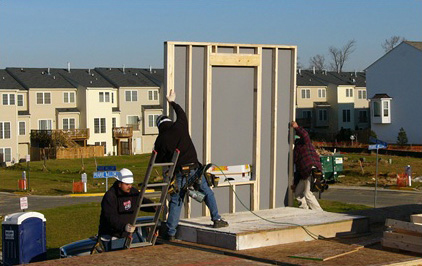Prototype decision support system to increase efficiencies and worker health
Goals & Objectives
A prototype decision-support-system (DSS) was developed, with a goal of providing designers with a first-cut evaluative tool for mitigating ergonomic hazards at the design stage (i.e., “Prevention through Design” or PtD).
3 construction workers putting a wall panel

Specific application is to residential construction using panelized (prefabricated) walls to take advantage of the centralized (panel) design involved. Major activities involved health effects and intervention research. In this project, proof-of-concept was established, and initial development activities were completed.
Project Approach & Activities
Work-related musculoskeletal disorders (WMSDs) are prevalent among residential construction workers; our long-term goal is to reduce these disorders, particularly those related to the handling of panelized walls. Such walls are used increasingly in residential construction, but are large and difficult to handle and result in high exposures to WMSD risk factors. Our work addresses the need for improved PtD, specifically by providing a software system that can be used by the panel designer or others (e.g., contractor). As such, changes at the design stage in the construction life cycle can positively affect a large number of construction sites and workers. Our multidisciplinary approach included both ergonomics and production issues as fundamental components, and both are improved through use of the system. It thereby addressed the need to support the economic/business case for PtD and increases the likelihood that the system will actually be used. The system also supports the development and assessment of interventions to reduce ergonomic exposures and risks.
We conducted several phases of work involving a combination of field measures and surveys, task analyses, software development, and lab-based ergonomic assessments. We surveyed and interviewed several designers, primarily regarding their practices, knowledge of ergonomics, and potential barriers to incorporating ergonomics in their designs. In parallel, a taxonomic description of construction using panels was developed, along with detailed task identification and work sampling efforts, based on extensive field observations. To complete this preliminary work, we surveyed construction workers who use panels and identified from them the most physically demanding tasks and body parts stressed. Using the results obtained from the designers, the field observations, and workers, we designed and completed a lab-based study. In this study, participants completed recreated tasks involving panelized walls, and we undertook a detailed assessment of ergonomic exposures and risk. We developed heuristic algorithms for panelization (dividing walls into panels) and stacking (how panels are formed into stacks, when each stack is delivered to the job site, and where they are dropped off), as well as various decision rules to be used by the workers for construction planning (what tasks to use, who does what and when, etc.). We also explored mathematical modeling for the stacking problem and developed several math models. An object-oriented, discrete-event simulator for panelized residential construction has been developed, as has a utility for generating 3D animations of the resulting construction process.
We concluded that there are clear inherent barriers to PtD in panelized construction and that tools are needed to help designers appreciate and address the consequences of their design. The lab study provided the first formal ergonomic investigation and evaluation of manual tasks used during construction with panelized walls. Our prototype software tool is the first to consider ergonomic aspects in addressing the panelization, stacking, and construction planning problems, and does so in an integrative manner. Initial reviews by potential users (designers and builders) have been quite favorable. Subsequent work is planned to: 1) improve and evaluate the DSS, 2) facilitate its implementation, and 3) conduct a field assessment of effectiveness.
Selected Outputs and Outcomes
- Kim, S., Seol, H., Ikuma, L.H. and Nussbaum, M.A. (2008) Knowledge and opinions of designers of industrialized wall panels regarding incorporating ergonomics in design. International Journal of Industrial Ergonomics. 38, 150-157.
- Nussbaum, M.A., Shewchuk, J.P., Kim, S., Seol, H. and Guo, C. (2009) Development of a decision support system for residential construction using panelized walls: approach and preliminary results. Ergonomics. 52, 87-103.
- Kim, S., Nussbaum, M.A. and Jia, B. (2011) Low back injury risks during construction with prefabricated (panelised) walls: effects of task and design factors. Ergonomics. 54, 60-71.
- Jia, B., Kim, S. and Nussbaum, M.A. (2011) An EMG-based model to estimate lumbar muscle forces and spinal loads during complex, high-effort tasks: development and application to residential construction using prefabricated walls. International Journal of Industrial Ergonomics. 41, 437-446.
- Kim, S., Nussbaum, M.A. and Jia, B. (2012) The benefits of an additional worker are task-dependent: assessing low-back injury risks during prefabricated (panelized) wall construction. Applied Ergonomics. 43, 843-849.
- Shewchuk, J and Guo, C. (2012) Panel stacking, panel sequencing, and stack locating in residential construction: a lean approach, Journal of Construction Engineering and Management. 138, 1006-1016.
- Kim, S. and Nussbaum, M.A. (2013) Performance evaluation of a wearable inertial motion capture system for capturing physical exposures during manual material handling tasks. Ergonomics, 56(2): 314-326.
Faculty and Facility
PI: Maury A. Nussbaum, Ph.D.; Co-Investigator: John Shewchuk, Ph.D.
Student Researchers
Cheng Guo, Courtney Haynes, Laura Ikuma, Bochen Jia, Sunwook Kim, Sourish Sarkar, Hyang Seol, PhD
Funding Source
"Prototype decision support system to increase efficiencies and worker health", NIOSH. (09/15/04 - 09/14/09) PI: M.A. Nussbaum; Co-Is: J. Shewchuk. Subproject within U19 OH 008308 (PI: Kleiner).
Sector: Construction
Discipline: Musculoskeletal Disorders
PI: Maury Nussbaum (Virginia Tech)
Co-I: John Shewchuk (Virginia Tech)


